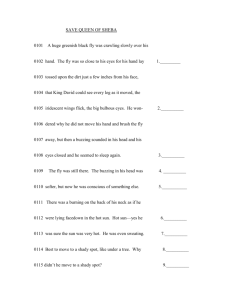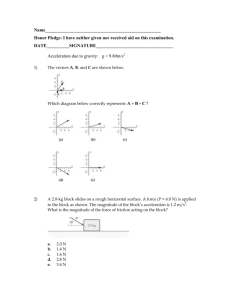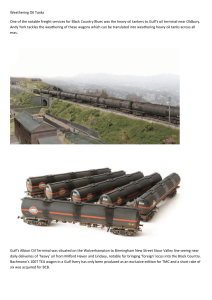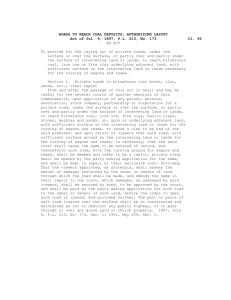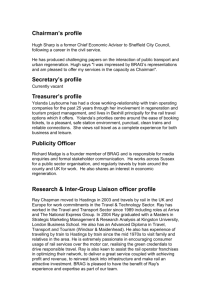A class 90 unmanned locomotive began to move in the slope of
advertisement
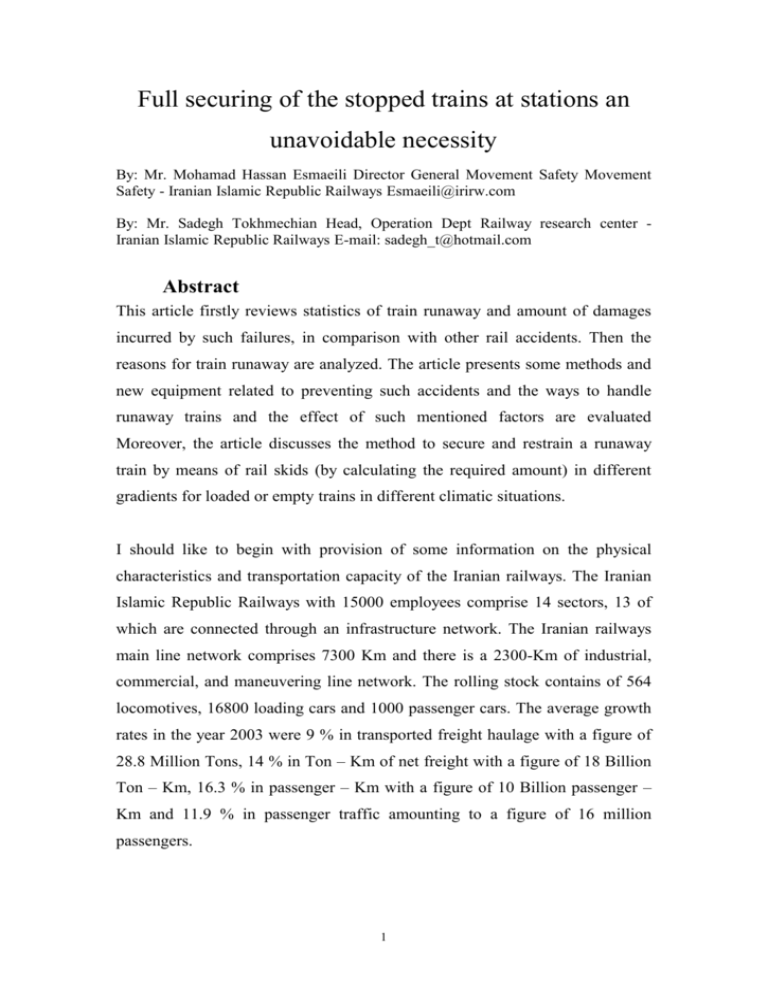
Full securing of the stopped trains at stations an unavoidable necessity By: Mr. Mohamad Hassan Esmaeili Director General Movement Safety Movement Safety - Iranian Islamic Republic Railways Esmaeili@irirw.com By: Mr. Sadegh Tokhmechian Head, Operation Dept Railway research center Iranian Islamic Republic Railways E-mail: sadegh_t@hotmail.com Abstract This article firstly reviews statistics of train runaway and amount of damages incurred by such failures, in comparison with other rail accidents. Then the reasons for train runaway are analyzed. The article presents some methods and new equipment related to preventing such accidents and the ways to handle runaway trains and the effect of such mentioned factors are evaluated Moreover, the article discusses the method to secure and restrain a runaway train by means of rail skids (by calculating the required amount) in different gradients for loaded or empty trains in different climatic situations. I should like to begin with provision of some information on the physical characteristics and transportation capacity of the Iranian railways. The Iranian Islamic Republic Railways with 15000 employees comprise 14 sectors, 13 of which are connected through an infrastructure network. The Iranian railways main line network comprises 7300 Km and there is a 2300-Km of industrial, commercial, and maneuvering line network. The rolling stock contains of 564 locomotives, 16800 loading cars and 1000 passenger cars. The average growth rates in the year 2003 were 9 % in transported freight haulage with a figure of 28.8 Million Tons, 14 % in Ton – Km of net freight with a figure of 18 Billion Ton – Km, 16.3 % in passenger – Km with a figure of 10 Billion passenger – Km and 11.9 % in passenger traffic amounting to a figure of 16 million passengers. 1 PASSENGER 20 Mln 15 10 5 0 1998 1999 2000 2001 2002 2003 2002 2003 2002 2003 2002 2003 PASSENGER-kM 12 10 Bln 8 6 4 2 0 1998 1999 2000 2001 Mln.tons FRIEGHT( Tonnage ) 35 30 25 20 15 10 5 0 1998 1999 2000 2001 FRIEGHT (Ton – Km ) Bln-ton-Km 20 15 10 5 0 1998 1999 2000 2001 2 Statistical Study of Accidents in Iranian Railways As it is seen in chart 5, total accidents of RAI has grown about 15% in 2003, compared to that of 2002 and it has got an about 10% increase in proportion to the average amount of 4 years ago. Chart 5- Total Number of Accident in Iranian Railways during 1999 - 2003 Number 466 450 427 500 400 300 200 100 0 1999 2000 2001 420 2002 484 2003 Year In case of calculating the growth of freight and passenger transportation, total accidents for 1 million trains-km has been increased from 12 accidents in 2002 to 13.5 accidents in 2003, but total accidents for every one billion transportation unit in 2003 has not a considerable change compared to 2002 (about 17 accident for every one billion ton-km per year). According to charts 6, 7 and 8, most of the accidents in 2003 were respectively related to derailment, collision with pedestrian, collision with rail vehicles and road_vehicles. 3 Collision with Vehicles Other Non Railway Accidents Collision with pedestrains Other Railway Accidents Fire Runaway Collision - Comparison of the share of different accidents in in Iranian Raiways Derailment Chart Collision w ith Vehicles Other Non Railw ay Accidents Other Railw ay Accidents Collision w ith pedestrains Fire Runaw ay Derailment Collision Chart . Comparison of the share of different accidents in in Iranian railways Chart . Number of accidents in Iranian Railways Derailment Collision Runaway Fire 4 Other Railway Collision with Collision with Accidents pedestrains Vehicles - Other Non Railway Accidents It can be conclude for the above charts that: 1. Derailment has almost been equal in all the understudied years, with a share of about 46% of total rail accidents in Iranian railways. 2. Collision has allocated 11% of total accidents in the last 5 years to itself. 3. In 2003, fire in rail vehicles has been 3% of total accidents and shows a growth of about 27% compared to the average amount of 4 years ago. Before 2003, cotton wagons have got the highest fire rates. 4. Other railway accidents include track being flood away, landslide, cutting slide, breaking of train, damages to railway equipment…. As it is seen, these accidents occur at a lower rate, however they may result in failures in the traffic flow, such as delay or blockage. 5. Accidents made by the collision of rail vehicles with pedestrians have amounted to about 21% in average in the last 5 years. 6. Accidents due to the collision with road vehicles have been about 9% of total accidents in 2003 and 10% of total accidents during last 5 years. 7. Runaway has been about 3% of total accidents in 2003 and it has a 57% growth compared with the previous 5 years period. Accidents due to runaway usually are quite widespread and intense. Accident related to trains runaway usually occurs due to lack of adequate air in order to provide train brake. Wagons runaway usually happens due to inadequate number of handbrakes and/or not putting rail skids; as it was experienced in Iranian railways in Feb. 17, 2004, when 51 wagons were broken loose from line 4 of Abu-Muslim station to be derailed, fired and exploded in Khayam station. This can be considered the most significant accident in Iranian railway history as regards to the disastrous consequences it made. In most runaway cases, the manpower is responsible. In other words, not paying any attention to brake test and not respecting movement general regulations, while shunting and/or securing stopped wagons, may lead to accident. International Experiences for Derailment Tanzania: A stopped passenger train was broke loose on June 24, 2002 and was crashed into a freight train between Igane and Masagali. The accident left 200 people dead and 924 injured. 5 The passenger train had been stopped because of technical failure in locomotive motor. While officers were trying to solve the problem, train brakes were broken loose for an unknown reason and the train began to move aback about 19 km in a speed of 200 km/h until it hit a freight train moving at the same direction. The passenger train was composed of 11 third class wagons and 6 second class wagons and its total capacity was 1216 people. England: A class 90 unmanned locomotive began to move in the slope of Viorli station in Edinburgh on Nov. 4, 2002 and was finally derailed and stopped at Cargitini station after running about 30 kilometers. The locomotive had been stopped from the beginning of the morning after returning from its night service. But the parking brake had become released. After the accident, railway authorities scrutinized all class 90 locomotives available, but there seemed to be no technical failure. Kenya A train moving from Mombassa to Nairobi made an accident on Aug. 19, 2000; six out of nine released wagons contained liquid gas. It seemed that the 9 wagons had been separated from the train. Authorities announced the separation had been due to technical failure in locomotive, which made the engineer to loosen the 9 wagons, but he cannot prevent their moving aback. The released wagons were derailed at Atiriver station and made a number of railway personnel houses around the station explode. More than 36 persons were injured and 16 people were killed out of which 13 were railway employees and their families. Australia With regard to the information gathered from internet sites, there has been an accident of train breaking loose in Australia as following: An empty driverless local train with 3 wagons was released from Broad Meadow station. The train movement was due to the gradient in the station. The train ran about 16.848 km when it collided into another local train stopped at Spencer station in Melbourne. The speed of train at the time of collision was estimated at about 120 km/h. The front wagon of the released train and the 6 locomotive of the stopped train were severely damaged and both trains were derailed. The drivers in the stopped train left it just in time, while 8 of the passengers in the train were injured. The research team announced that the train has broken loose because the brakes were released when the driver had been up to doing the formalities to return the train to Melbourne. Also the unintentional train movement has been due to the fact that the parking brake has not been active. The research team didn’t regard other factors (e.g. tiredness and physical situation of the driver and/or other employees of the station, train and track) as effective in the occurrence of the accident. One of the most common tools to contain stopped trains and prevent them from breaking loose is application of rail skids to keep away rail vehicles in plane or slope lands from abrupt release. Therefore this article discusses different kinds of rail skids, the accidents related to them and the adequate number to restrain wagons. Rail skids can be selected according to the type of rail, diameter and type of wheel, amount of freight, type and weight of wagon, forces incurred to wagons, gradient level, Here some samples of common rail skids are presented, each are designed for a specific task. For example some rail skids are manufactured to prevent train runaway, while some others are used to take out runaway trains from rail tracks (below pictures). 7 8 9 According to the existing regulations in Iranian railways, the wagons should be secured and blocked by adequate hand brakes after they are completely stopped; one hand brake should be applied for every 50 tons in mountainous areas, for every 150 tons in plain areas and for every 100 tons in other spots. Also the wagons set should be secured by putting rail skids at both sides of wagons and by coupling wagons together. Rail-skid-related accidents can be classified into 2 groups: 1. Accidents as a result of a shortage or lack of adequate rail skids, that may consequently lead to collision or derailment. There have been totally 41 runaway accidents during 1999-2002. 2.Accidents that occurs when the rail skids are not removed from under the train while the train is running leading to derailment. There have been 27 derailment cases during 1999-2002. Number of Required Rail Skids to Restrain a Train The gradient for railway tracks is usually specified and announced in %0, 2%0 or 5%0, … These amounts has a specific meaning in the dynamic of train movement. 2%0 means 2 kg accelerating force for every ton of train weight. For instance if the gradient of a station is 2%0 and a 4-axle train with 50 loaded wagons stops at one of its tracks, while the gross weight of each wagon is 80 tons, the general accelerating force incurred to the wagons sets is equal to: 80 ton × 50 wagon × 2 accelerating force to one wagon = 8000 kgf Therefore to prevent the runaway of the wagons set, a force of about 8000 kgf should be released through application of adequate rail skids under the wagons (in case rail skids are used). Restraining wagons and the resistance force occurs versus the movement of a set of wagons when the rolling of wagon wheels is replaced with their slip. Therefore a rail skid can reflect a preventive force as following: R= q × f × 1000 kgf N Where: R: resistance Q: gross weight of wagon (in tons) N: number of wagon axles f: coefficient of friction, which is considered 0.17 for iron on iron 10 Therefore in the above example, every rail skid incurs a force about 3400 kgf: R= 80 × 0.17 × 1000 = 3400 kgf 4 With regard that the general accelerating force is 8000 kgf, naturally a preventive force of 3400 kgf can confront it and make the set of 50 wagons move with the rail skids. Therefore to restrain these wagons (8000 kgf accelerating force), at least 3 rail skids are required in ordinary situation. In case hand brake is not used to restrain wagons, and only rail skid is applied, the following items should be taken into consideration: 1. In lines with a 0 %0 gradient: a rail skid should be placed at both ends of empty and loaded wagon sets, regardless of the number of wagons. 2. In steeply lines: in order to restrain 200 axles of loaded wagons, the required number of rail skids is equal to the amount of gradient (%0) plus 2. 3. In steeply lines: in order to restrain 200 axles of empty wagons, the required number of rail skids is equal to the amount of gradient (%0) plus 3. R= q 24(weight of empty wagon) × f × 1000 → N 4 × 1000 × 0.17 = 1020 24 ton × 50 wagons × 2 = 2400 4.In case the axles of the wagons set to be restrained are more and/or less than 200 axles, the number of required rail skids is calculated by the number of real axles to 200 wagons. If the number of rail skids was the fraction of a number, it should be rounded toward the larger number. By means of above regulations, the number of required rail skids for the above example shall be: 50(wagon ) 4(axle) (2 2) =4 200 And for a set of empty wagons with 80 axles and a gradient of 2.5 %0, 3 rail skids are required. 80 ( 2.5 3) = 2.5 → 3 rail skids 200 5.The above criteria shall be 1.5 times more in stations where the surface of rails are soaked in oil or other oil products. 6. If the tracks in stations are located on the latitudinal cross-section breakage, the average gradient is regarded as the basis to restrain a set of wagons that occupies useful length of tracks. If wagons are restrained in 11 sections of track with constant gradient, the gradient for a specified section is the basis. Example: 1.5 %0 300 m 2.5 %0 400 m Average gradient: 0.0025 400m 0.0015 300 = 0.00207 → 2.07 %0 700 7. Rail skids should be put under different axles of the wagons sets, so that their sliding tip is in contact with the wheel. 8.In areas where strong winds blows in more than 10 m/s in the direction of track gradient, one other rail skid should be added to the calculated number of rail skids. In case of stormy weather, 2 rail skids should be added to the calculated number. Train Runaway Accident in Abu Muslim Station According to the telegram No. 679 dated 17 Feb. 2003, on 3:55 a.m., 51 stopped wagons at line 4 in Abu Muslim station (km 850) were broken loose toward Kashmar station. The set of wagons included 17 wagons of sulphur, 6 wagons of gasoline, 7 wagons of chemical fertilizer (nitrate ammonia), 10 wagons of cotton and 11 empty wagons. The wagons had been secured by rail skids. When the first Tehran-Mashad passenger train passed over the station, the rail skid was crushed and wagons began moving. Authorities put two more rail skids and a bag of gravel under wagons wheels, but it was useless. It should be noted that the gradient of line 4 in Abu Muslim station has been registered 1.8 %0. As soon as the runaway occurred, Abu Muslim station authorities informed the accident to the headquarters of the region (Mashad), and they immediately announced the stations on the way and order to stop any passenger trains. The person in charge of traffic for Kashmar station (the first neighboring station) informed the passenger train that was moving in the opposite direction towards runaway wagons and the train returned to Kashmar station and stopped at line 2. This way a disastrous accident was prevented (i.e. collision of passenger train with the set of broken loose wagons). The runaway wagons passed by the passenger train at Kashmar station and derailed at the switch point of Khayam station (km 810) and collided into a 12 stopped freight wagon (with 43 wagons) at line 3, and got into fire. Khayam station has got 5 lines, but lines 1, 2 and 3 were blocked in order to construct an underpass to facilitate the movements of inhabitants in the 2 adjacent villages. Line 2 was connected to line 4 by a temporary switch. However the 4 (empty) wagons of these 51 runaway wagons were first passed the switch to this station, then derailed and stopped near Neishabour station, where another underpass (km 791) was being constructed (at about 4:20 a.m.) When the wagon containing gasoline collided into the stopped locomotive at line 5, the container wagons got into fire. The firemen were trying to handle the fire. But a terrible explosion occurred at 9:42, because of the fire in the wagons containing chemical fertilizer (nitrate ammonia). The 41 wagons were exploded into pieces and a pit was made with a depth of 30 meters at the very spot of explosion. The explosion wave broke the glasses to a radius of 120 km. Major parts of neighboring villages were destructed and there were totally 259 people killed and more than 1000 injured. The accident brought about 25 million US dollars. 13

